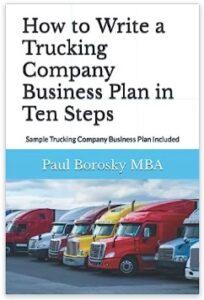How to Write a Trucking Business Plan
The demand for over-the-road and box trucking business plans has experienced significant growth over the past few years. Several vital reasons are contributing to this upward trend.
Firstly, the over-the-road trucking industry has seen substantial expansion due to the rising demand for products, particularly those shipped from overseas manufacturers. The transportation of goods from ports to warehouses or retail stores necessitates the involvement of big rigs or semi-truck companies, which in turn requires well-structured business plans. Moreover, the scarcity of over-the-road truckers has resulted in wholesalers and retailers paying increasingly higher prices per mile for product deliveries. This factor has sparked the interest of more individuals in establishing over-the-road trucking businesses, further emphasizing the need for comprehensive trucking company business plans.

In the case of the box truck industry, its growth can be attributed to the advantages it offers, such as the relative ease of driving compared to semi-trucks. Box trucks also possess the ability to efficiently deliver large purchases like refrigerators and furniture to multiple customers in a single route. This unique specialty or niche contributes to the increasing demand for box truck businesses and the need for well-designed plans.
Regardless of the specific reasons behind a box truck company or an over-the-road truck driving company's need for a business plan, Quality Business Plan's business plan writer has found that its preparation, or at least having a template, is a vital strategic move for any trucking company. In light of this, our team of over-the-road truck company business plan writers and box truck business plan writers has compiled tips and tricks to assist business owners in crafting effective trucking company business plans or templates (7/23).
CLICK HERE TO CHECK OUT OUR TRUCKING COMPANY BUSINESS PLAN TEMPLATES!!
Executive Summary for a Trucking Business Plan.
The executive summary of a Trucking business plan serves as a concise overview of the critical aspects of the business. It is essential to address specific points to understand your organization clearly.
First, mention the type of business structure your trucking company will adopt. Trucking businesses commonly operate as sole proprietorships or limited liability companies (LLCs). Sole proprietors are often favored when truckers work with brokers for short-term transportation jobs, as their insurance coverage is typically sufficient to handle any liability. However, the LLC structure is often preferred when a trucking company expands to include multiple truck drivers. Please make sure that this discussion is included in the executive summary of your trucking business plan.
Also, the executive summary should outline how your business will cater to customers and meet their needs. Trucking business owners may acquire job contracts through brokers or directly from manufacturers. The source of your job contracts will influence the structure and operations of your trucking company. Address how your business model aligns with your customer's requirements in the executive summary of your business plan.
By including these essential points in the executive summary of your Trucking business plan, you will provide a clear picture of your business structure and how it caters to customer needs. This summary will effectively set the stage for the detailed sections of your plan.
Company Information for a Trucking Business Plan.
The company information section of a Trucking business plan should begin by addressing the problem the company aims to solve for its clients. The section should then delve into the "Who, what, where, when, why, and how" aspects of the company's operations. One common problem that trucking companies resolve for their customers is the need for efficient product transportation from one location to another. This problem applies to various trucking companies in the industry.
For instance, over-the-road truckers primarily transport products from manufacturers to wholesalers. On the other hand, local and regional truckers focus on transporting goods from warehouses to retailers or directly to consumers. Consequently, articulating the problem statement in the company information section of the business plan is often a straightforward process.
By addressing the problem statement, you understand the core issue that your trucking company wants to solve. This sets the stage for me to explain how your company will provide adequate transportation solutions and meet client's needs in various industry sectors.
Need Help Writing a Trucking Business Plan?
Call or Text Paul, Doctoral Candidate, MBA.
321-948-9588
Email: Paulb@QualityBusinessPlan.com
CLICK HERE TO CONTACT US TODAY!!!
Product Description for a Trucking Business Plan.
In the product description section of a Trucking business plan, it is essential to highlight your transportation services' core offering and specialization. Trucking businesses primarily generate revenue by providing transportation services for various products, charging based on mileage. However, it is common for truck drivers to specialize in specific types of products, offering niche transportation services.

For example, some drivers may specialize in transporting hazardous materials, requiring specialized training and adherence to strict safety regulations. Other drivers may have experience transporting refrigerated or frozen goods, ensuring the preservation and proper handling of temperature-sensitive products. I want to showcase your niche transportation services and expertise in the trucking business plan and your unique value proposition and positioning within the industry.
Also, it would be best to include an estimated average charge per mile in this discussion. This helps potential investors or stakeholders gain a clear understanding of your pricing structure and revenue generation potential. Providing this information shows your understanding of the market and the financial aspects of your trucking business.
By describing your specialized transportation services and including the estimated average charge per mile, you effectively convey the distinct value and expertise your trucking company offers to clients. This allows readers of the business plan to gauge your business venture's market potential and profitability.
Competitive Advantages for a Trucking Business Plan.
The Trucking industry has experienced significant growth in recent years due to the ongoing demand for efficient product transportation. As mentioned in the previous section, a familiar competitive advantage for truck drivers is their specialization in transportation services. These specializations can encompass various areas such as hazardous materials, flatbed trucking, refrigerated and frozen goods transportation, and other specific niches. While highlighting your specialty in the product description section of the business plan is crucial, it is equally important to outline the specific strategies and advantages that will differentiate your company from other specialist drivers.
In a trucking business plan, you can include several competitive advantages that set your company apart from others in the industry. Here are some examples:
- Technological Advances: Emphasize how your company utilizes technological advancements for logistical planning, such as route optimization software, real-time tracking systems, or digital freight matching platforms. This enables efficient operations, better customer service, and cost optimization.
- Networking: Could you highlight your efforts in building and maintaining solid relationships with manufacturers, wholesalers, retailers, and other industry stakeholders? Vital networking can lead to repeat business, referrals, and strategic partnerships that give your company a competitive edge.
- Business Brokers: Describe how you leverage the services of one or more business brokers to ensure a consistent flow of contracts and job opportunities. Collaborating with brokers expands your reach, provides access to a broader customer base, and enhances your ability to secure profitable transportation jobs.
- Customer Service Excellence: Please be aware that you are committed to exceptional customer service, such as timely and reliable deliveries, responsive communication, and a proactive approach to problem-solving. Providing a superior customer experience can lead to customer loyalty, positive word-of-mouth, and a competitive advantage in the industry.
- Safety and Compliance: Please highlight your company's strict safety protocols, adherence to regulatory requirements, and commitment to maintaining a clean safety record. Demonstrating a solid safety culture and compliance with industry regulations instills trust in your customers and sets you apart from competitors.
By clearly articulating these competitive advantages in your trucking business plan, you showcase how your company stands out in the industry and why potential investors, partners, or lenders should choose to work with you. Remember to tailor these advantages to your company's unique strengths and value proposition.
Location Description for a Trucking Business Plan
The location of a Trucking facility plays a crucial role in the business's success. Solo trucking companies typically utilize the truck's cab as their office when considering the facility's interior due to constant travel. Therefore, having a dedicated home location is unnecessary and often an inefficient use of resources. However, a home location becomes essential as a trucking company grows and employs more truckers. This location should include one or more desks for the owner and any required support staff. The square footage for such a facility typically ranges from 500 to 1,000 square feet.
Regarding the general location of the Trucking facility, it is advantageous to choose a site near interstates and in areas with ample parking space. Trucking companies require parking areas for their large rigs, making a sizeable parking lot necessary. Therefore, when truckers establish their businesses, they often seek areas with a small building for office work and a large parking lot to accommodate big-rig trailers. Furthermore, these facilities should be located near easily accessible interstates to facilitate efficient transportation and logistics operations.
By selecting a location near interstates and with sufficient parking space, you position your trucking company for success. This strategic choice ensures convenient access to major transportation routes, expedites deliveries, and provides ample parking for your fleet. Additionally, proximity to interstates allows for streamlined logistics and access to a broader market, enhancing your company's competitiveness in the industry.
Target Market for a Trucking Business Plan.
The target market for a Trucking business largely depends on the specialty or niche of the truck drivers or trucking company. Different specialties cater to specific industries and address their unique transportation needs. When identifying the target market, aligning it with the problem statement identified in the business plan is essential. Your trucking company should aim to solve a specific problem for the target market.

For example, if your trucking company specializes in transporting hazardous materials, your target market would be manufacturers of hazardous materials. Additionally, brokers with extensive networks in the hazardous material industry could be part of your target market. On the other hand, if your company specializes in refrigerated and frozen goods transportation, your target market would be food manufacturers.
When summarizing the target market information in the trucking business plan, clearly understanding your target industries and businesses is essential. Please describe how your services directly address their transportation needs and solve their unique challenges. Could you highlight the potential market size, growth trends, and competitive advantages that favorably position your company within the target market?
By clearly defining and summarizing your target market in the business plan, you demonstrate a thorough understanding of your customers and their specific needs. This helps investors, lenders, and stakeholders recognize your trucking business's market potential and viability.
Industry Research for a Trucking Business Plan
Based on our business plan writer's research, the leading industry segment that Trucking competitors operate in is long-distance freight trucking. This segment focuses on transporting products from manufacturers to wholesalers across the country. Over the past 12 months, the trucking industry has reached approximately $220 billion in revenues.

The industry's performance over the past five years has experienced an annual growth rate of about 2.6%. However, industry experts project a slightly decreased growth rate of around 2.3% in the next five years. Currently, around 470,000 trucking companies are operating in the United States, indicating significant fragmentation within the industry.
Despite the fragmented nature, trucking business owners have generated about $13.2 billion in revenues. This highlights the potential for success within the industry. Additionally, due to the labor-intensive nature of trucking, substantial wages of approximately $57 billion were paid out.
Regarding revenue sources, approximately 67% of the total revenues in the industry were generated from product transportation services. The remaining 30% of revenues were derived from other services related to trucking. This indicates that innovative trucking companies have the opportunity to offer complementary services to augment their transportation revenue streams.
Owner and Management Section of a Trucking Business Plan
The owner and management section of a Trucking business plan differs from other types of organizations due to the industry's unique structure. In many cases, trucking companies are primarily operated and managed by their owners, who often serve as the sole employees. As highlighted in the industry research section, this is a common scenario in the trucking industry.
When addressing the owner and management section in a trucking business plan, it is important to initially discuss the company's current state, which typically involves a single owner fulfilling various roles and responsibilities. Emphasize the owner's qualifications, experience, and expertise in the trucking industry. Highlight their role as the business's driving force and ability to successfully handle the operational and managerial aspects.
However, it is crucial to acknowledge the future growth and expansion of the organization. As the trucking company develops and expands its operations, additional management staff and positions will likely be required. In the business plan, provide a projection of the potential management positions that may be needed as the company grows. This demonstrates ambition, foresight, and a strategic approach to the organization's long-term development.
Funding Request for a Trucking Business Plan
When you outline the funding request in a Trucking business plan, it is essential to be specific and detailed about the financial requirements of starting the business. Starting a trucking company involves significant upfront costs, such as purchasing a big rig and potentially a trailer, which can range from $50,000 to well over $150,000. To effectively present the funding needs, follow these steps:
- Specify the Dollar Amount: Clearly state the specific amount of funding needed or desired to launch the trucking business. This provides clarity to potential investors or lenders regarding the financial requirements.
- Breakdown into Categories: Divide the funding needs into categories to provide a comprehensive breakdown of expenses. Examples of categories for a trucking company may include the purchase of a big rig, trailer, miscellaneous equipment, GPS systems, advertising, licensing, and office supplies/equipment (e.g., laptop, smartphone).
- Allocate Budgets: Align budgets to each line item or category to specify the estimated costs associated with each aspect of the business. This demonstrates a thorough understanding of the financial requirements and helps stakeholders assess the feasibility of the funding request.
- Calculate Total Funding Request: Add the amounts for each line item or category to obtain the required funding. Please ensure that the total amount matches the dollar amount stated at the beginning of the funding request section.
Financials for a Trucking Business Plan.
Constructing the financials for a Trucking business plan involves several key steps. Firstly, estimate the daily mileage that truckers will drive to determine the revenue potential. Next, establish an average charge per mile to project the income generated. Consider the average gasoline price to account for fuel costs, a significant expense in the industry. With these foundations, develop a financial model to outline daily revenues and costs. Expand these numbers monthly using growth rates to capture potential fluctuations and progress. Deduct fixed costs such as truck payments, smartphone bills, and rent from the monthly revenues. Finally, utilize growth rates to project an annual profit and loss statement. Ensure the financial model is comprehensive, realistic, and supported by accurate data. By including these financial projections in a professionally prepared trucking business plan, potential investors and stakeholders gain insight into the Trucking business's financial viability and potential profitability.
Author: Paul Borosky, Doctoral Candidate, MBA., Author
Owner of: Quality Business Plan and Quality Business Consultant
Date: 2/19/24